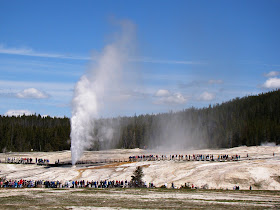Say what? Oh yeah, I was once working on a series about our journey across the Pacific Northwest and the Northern Rocky Mountains in June called a Convergence of Wonders (the name derived from the influence of the Cascadia Subduction Zone, a convergent boundary). I had reached day 10 when we arrived and started exploring Yellowstone National Park, but was, uh, slightly distracted by another two week trip, a more personal trip. I'm home now, and I expect to wrap up this series now.
So what is today's title about? Well, the steam at Yellowstone National Park actually does have some bad stuff in it (high levels of carbon dioxide and hydrogen sulfide) and can cause some real problems for people with asthma and other conditions, but there is no blue steam or orange steam, except as it reflects the colors beneath it. The picture at the beginning is of Grand Prismatic Spring in the Midway Geyser Basin.
Yellowstone is justly famous for her collection of geothermal features; the 300 geysers in the park account for about two-thirds of all the geysers in the entire world. There are thousands of other fascinating geothermal features as well, including fumaroles, boiling mudpots and hot springs.
Fumaroles are steam vents. Sometimes fumaroles are short-lived features in the immediate aftermath of violent volcanic eruptions, but in places like Yellowstone (and Lassen Volcanic National Park in California) they are more permanent in nature. Sometimes they are transitional in nature, depending on the time of year and availability of groundwater. Some geysers erupt so rarely that they might as well be considered fumaroles that occasionally explode.
Boiling mudpots are cauldrons of hot acidic mud derived from the weathering of the surrounding volcanic rock. The bubbling mud above is the Fountain Paint Pot near the Lower Geyser Basin.
Hot springs are carefully defined as springs that have, uh, hot water. They are one of the most beautiful of Yellowstone's geothermal features due to the interplay of color caused by select absorption of sunlight and the presence of extremophile bacteria (which can survive in near-boiling water). Grand Prismatic Springs is one of the most spectacular features in the national park system, although it is hard to see except from above (there is a trail on the nearby hillside).
The hot spring we looked at in the last post, Mammoth Hot Spring, was a mountain of calcium carbonate derived from the solution of limestone layers along the pathway of groundwater movement. Most of the hot springs in the park are within a rhyolite caldera, and most of the springs have much less voluminous deposits made mostly of silica. White Dome Geyser, below, is the highest silica dome in the park at twelve feet.
No trip to Yellowstone would be complete without a visit to Old Faithful. At least that's what I've heard. I managed (quite on purpose) to miss two eruptions while we were there. There's just something about having amphitheatre seating and a giant crowd of people that is off-putting.
So what were these people standing around for? The rangers seemed far more excited about convincing people to see an eruption of Beehive. Is that it, that little bit of spray?
Oh, there it is! It produced a spectacular eruption!
As we started south to leave the park, we made a short stop at Grant Village to have a look at Yellowstone Lake, a huge body of water (132 square miles) that is the largest freshwater lake above 7,000 feet in the country, and possibly the world. The lake lies within the Yellowstone Caldera, and recent activity has caused parts of the lake bottom to tilt. Some shorelines are rising and others are falling.
I also took a moment to say hi to Nina Fitzgerald, a ranger at Yellowstone. She is a fellow geoblogger, and has been writing a great series of posts about her experiences in the park system. You can catch her work at Watch For Rocks.
We ended our day by traveling south along the Rockefeller Byway to Grand Teton National Park. More in the next post!













Nice pics. Been to Yellowstone and Lassen a couple times and never even thought of the steam possibly being bad for you. Live and learn I guess.
ReplyDeleteGreat series, awesome trip!
Yellowstone smells like rotten eggs. But well worth breathing, if possible, to see this most amazing landscape. I too was disappointed in Old Faithful. Looking into the depths of colorful water surrounded by fluid deposits from both near and far blew me away.
ReplyDeleteGlad you got to see Nina.
I found the post on your stop at Grant Village. It was great meeting you and Mrs. Geotripper, and being able to put a face to a blog name!
ReplyDelete